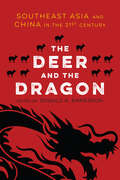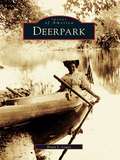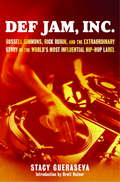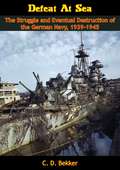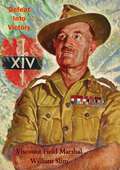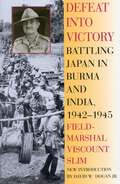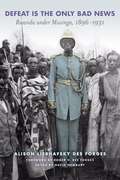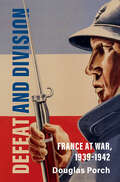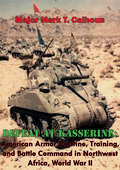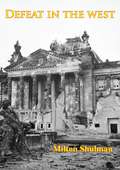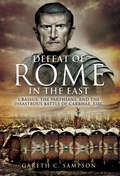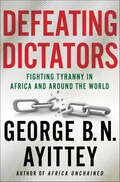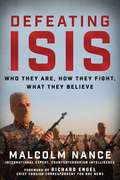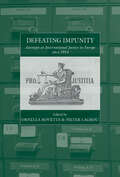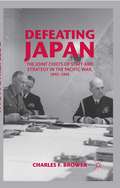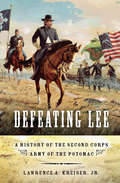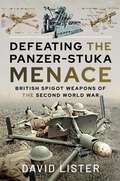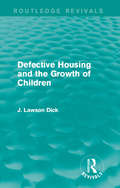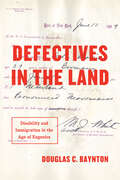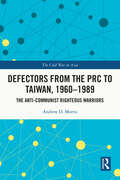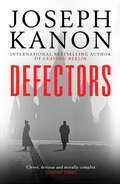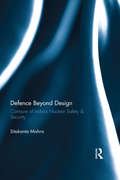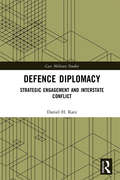- Table View
- List View
Deer and the Dragon, The: Southeast Asia and China in the 21st Century
by Donald K. EmmersonWill the nations of Southeast Asia maintain their strategic autonomy, or are they destined to become a subservient periphery of China? This book's expert authors address this pressing question in multiple contexts. What clues to the future lie in the modern history of Sino-Southeast Asian relations? How economically dependent on China has the region already become? What do Southeast Asians think of China? Does Beijing view the region in proprietary terms as its own backyard? How has the relative absence, distance, and indifference of the United States affected the balance of influence between the US and China in Southeast Asia? The book also explores China's moves and Southeast Asia's responses to them. Does China's Maritime Silk Road through Southeast Asia herald a Pax Sinica across the region? How should China's expansionary acts in the South China Sea be understood? How have Southeast Asian states such as Vietnam and the Philippines responded? How does Singapore's China strategy compare with Indonesia's? How relevant is the Association of Southeast Asian Nations? To what extent has China tried to persuade the "overseas Chinese" in Southeast Asia to identify with "'the motherland" and support its aims? How are China's deep involvements in Cambodia and Laos affecting the economies and policies of those countries? "This rich collection," writes renowned author-journalist Nayan Chanda, answers these and other questions while offering "fresh insights" and "new information and analyses" to explain Southeast Asia's relations with China.
Deerpark (Images of America)
by Brian J. LewisBounded by three rivers and a mountain range, the town of Deerpark lies in the southwestern corner of Orange County. Once the frontier of America, the area took its name from what early settlers called their neighbor's fenced tract: McDaniel's Deer Park. The town has seven hamlets-Cahoonzie, Cuddebackville, Godeffroy, Huguenot, Rio, Sparrowbush, and Westbrookville-shaped and identified by their geography.Deerpark highlights a community that has what is believed to be the oldest one-hundred-mile road in the country, the Old Mine Road. Appearing in this pictorial history are the Delaware and Hudson Canal, which transformed the town, and the railroad, which spawned a thriving resort industry. Also shown are filmmaker D.W. Griffith, who between 1909 and 1911 made silent movies using the mountains and rivers as a backdrop, and many ancestors of present-day residents.
Def Jam, Inc.: Russell Simmons, Rick Rubin, and the Extraordinary Story of the World's Most Influential Hip-hop Label
by Brett Ratner Stacy GuerasevaIn the early '80s, the music industry wrote off hip-hop as a passing fad. Few could or would have predicted that the improvised raps and raw beats busting out of New York City's urban underclass would one day become a multimillion-dollar business and one of music's most lucrative genres. Among those few were two visionaries: Russell Simmons, a young black man from Hollis, Queens, and Rick Rubin, a Jewish kid from Long Island. Though the two came from different backgrounds, their all-consuming passion for hip-hop brought them together. Soon they would revolutionize the music industry with their groundbreaking label, Def Jam Records.Def Jam, Inc. traces the company's incredible rise from the NYU dorm room of nineteen-year-old Rubin (where LL Cool J was discovered on a demo tape) to the powerhouse it is today; from financial struggles and scandals-including The Beastie Boys's departure from the label and Rubin's and Simmons's eventual parting-to revealing anecdotes about artists like Slick Rick, Public Enemy, Foxy Brown, Jay-Z, and DMX. Stacy Gueraseva, former editor in chief of Russell Simmons's magazine, Oneworld, had access to the biggest players on the scene, and brings you real conversations and a behind-the-scenes look from a decade-and a company-that turned the music world upside down. She takes you back to New York in the '80s, when late-night spots such as Danceteria and Nell's were burning with young, fresh rappers, and Simmons and Rubin had nothing but a hunch that they were on to something huge.Far more than just a biography of the two men who made it happen, Def Jam, Inc. is a journey into the world of rap itself. Both an intriguing business history as well as a gritty narrative, here is the definitive book on Def Jam--a must read for any fan of hip-hop as well as all popular-culture junkies.
Defeat At Sea: The Struggle and Eventual Destruction of the German Navy, 1939-1945
by C. D. BekkerThis is the story of the German Navy during 1939-1945.Inadequately prepared for the Second World War, the navy led a bitter struggle on all seas, and in the end was subjected to an overwhelming defeat. More than 120,000 lives were lost, including many individuals whose firsthand accounts make up this gripping and detailed documentary report; they are indispensable if the spirit of that era and the resulting events, as well as the willingness to take action and the courage to sacrifice these men, are to be fully understood…Richly illustrated throughout, former WWII German naval officer Hans Dieter Berenbrok first published this book in German in 1953, under the pseudonym Cajus Bekker and the title Kampf und Untergang der Kriegsmarine. Ein Dokumentarbericht in Wort und Bild. It draws on a vast collection of military records, private archives, and countless personal interviews. It was subsequently published in English in 1955.
Defeat Into Victory
by Viscount Field Marshal William SlimField Marshal William Slim stands alongside Montgomery as the outstanding British field commander of World War II. Defeat Into Victory is his classic account of the Burma campaign: a story of retreat, attrition and final hard-fought victory over the Japanese. Told by a commander always at the centre of events, this is a narrative which captures both the high drama and the harsh reality of war.-Print ed.
Defeat Into Victory: Battling Japan in Burma and India, 1942-1945
by Field-Marshal Viscount SlimField Marshal Viscount Slim (1891-1970) led shattered British forces from Burma to India in one of the lesser-known but more nightmarish retreats of World War II. He then restored his army's fighting capabilities and morale with virtually no support from home and counterattacked. His army's slaughter of Japanese troops ultimately liberated India and Burma.The first edition of Defeat Into Victory , published in 1956, was an immediate sensation selling 20,000 copies within a few days. This is an updated version with a new introduction by David W. Hogan Jr.
Defeat Is the Only Bad News
by Alison Liebhafsky Des ForgesA Rwandan proverb says "Defeat is the only bad news. " For Rwandans living under colonial rule, winning called not only for armed confrontation, but also for a battle of wits-and not only with foreigners, but also with each other. InDefeat Is the Only Bad NewsAlison Des Forges recounts the ambitions, strategies, and intrigues of an African royal court under Yuhi Musinga, the Rwandan ruler from 1896 to 1931. These were turbulent years for Rwanda, when first Germany and then Belgium pursued an aggressive plan of colonization there. At the time of the Europeans' arrival, Rwanda was also engaged in a succession dispute after the death of one of its most famous kings. Against this backdrop, the Rwandan court became the stage for a drama of Shakespearean proportions, filled with deceit, shrewd calculation, ruthless betrayal, and sometimes murder. Historians who study European expansion typically focus on interactions between colonizers and colonized; they rarely attend to relations among the different factions inhabiting occupied lands. Des Forges, drawing on oral histories and extensive archival research, reveals how divisions among different groups in Rwanda shaped their responses to colonial governments, missionaries, and traders. Rwandans, she shows, used European resources to extend their power, even as they sought to preserve the autonomy of the royal court. Europeans, for their part, seized on internal divisions to advance their own goals. Des Forges's vividly narrated history, meticulously edited and introduced by David Newbury, provides a deep context for understanding the Rwandan civil war a century later.
Defeat and Division: France at War, 1939–1942 (Armies of the Second World War)
by Douglas PorchDefeat and Division launches a definitive new account of France in the Second World War. In this first volume, Douglas Porch dissects France's 1940 collapse, the dynamics of occupation, and the rise of Charles de Gaulle's Free France crusade, culminating in the November 1942 Allied invasion of French North Africa. He captures the full sweep of France's wartime experience in Europe, Africa, and beyond, from soldiers and POWs to civilians-in-arms, colonial subjects, and foreign refugees. He recounts France's struggles to reconstruct military power within the context of a global conflict, with its armed forces shattered into warring factions and the country under Axis occupation. Disagreements over the causes of the 1940 debacle and the subsequent requirement for the armistice mirrored long-standing fractures in politics, society, and the French military itself, as efforts to reconstitute French military power crumbled into Vichy collaboration, De Gaulle's exile resistance, Alsace-Moselle occupation struggles, and a scuffle for imperial supremacy.
Defeat at Kasserine: American Armor Doctrine, Training, and Battle Command in Northwest Africa, World War II
by Major Mark T. CalhounThe 1st Armored Division was the first American armored unit to enter combat against German panzer divisions in World War II. A product of the contentious mechanization process between the First and Second World Wars, the division soon found itself to be outmatched by its German foe. Following a relatively easy victory against the Vichy French after the amphibious landings of Operation Torch, the division lost a series of battles to the Germans, culminating in a decisive defeat at Kasserine Pass. Doctrine (both institutional and equipment), training, and battle command all proved to be problematic for the division. The central question is: Did the 1st Armored Division lose the battle of Kasserine Pass because of deficiencies in American armor doctrine, training, or battle command? An analysis of the Tunisian campaign focusing on these three areas demonstrates that faulty training and inept battle command were partially responsible for the division's defeat; however, the primary reason the 1st Armored Division lost the battle of Kasserine Pass was that it operated in accordance with flawed institutional doctrine and utilized inferior equipment.
Defeat in the West (Sven Hassel War Classics)
by Milton Shulman Maj.-Gen. Sir Ian JacobTHE STORY OF THE COLLAPSE OF THE GERMAN ARMIES IN THE WEST AND A STUDY OF THE HISTORY OF WORLD WAR II, AS TOLD FROM THE GERMAN POINT OF VIEWIn 1945, the once mighty Wehrmacht was reduced to a pathetic shadow of its former self as the thousand-year Reich lay in ruins. The war in the West had been lost and its protagonists scattered in prisoner of war camps across Europe.Author Milton Shulman joined the Canadian Army HQ three months before D-Day as a major and was promoted to intelligence officer by war's end. As part of his duties, he made close personal contact with the German Army throughout intelligence operations in France, Belgium, Holland and Germany. While still in uniform, he also interviewed many of the captured German generals in the following months and years, including Gerd von Rundstedt, ‘Sepp’ Dietrich and Kurt Meyer—26 in all. From them, Major Shulman learnt why it was that such a superbly armed body of fighting men suffered such a calamitous defeat.This absorbing book is the result of those interviews. First published in 1947, it was the first account to reveal the truth of what happened in the war: how Hitler and his General Staff planned their campaigns, how the discipline and ignorance of the German military machine served Hitler well and Germany badly—and why victory finally slipped from their hands.“The best and most vivid account of the German collapse”—Hugh Trevor Roper, The Sunday Times
Defeat of Rome in the East: Crassus, the Parthians, and the Disastrous Battle of Carrhae, 53 BC
by Gareth SampsonIn 53BC the Proconsul Marcus Crassus and 36,000 of his legionaries were crushed by the Parthians at Carrhae in what is now eastern Turkey. Crassus' defeat and death and the 20,000 casualties his army suffered were an extraordinary disaster for Rome. The event intensified the bitter, destructive struggle for power in the Roman republic, curtailed the empire's eastward expansion and had a lasting impact on the history of the Mediterranean and the Middle East. It was also the first clash between two of the greatest civilizations of the ancient world. Yet this critical episode has often been neglected by writers on the period who have concentrated on the civil war between Pompey and Caesar. Gareth Sampson, in this challenging and original study, reconstructs the Carrhae campaign in fine detail, reconsiders the policy of imperial expansion and gives a fascinating insight into the opponents the Romans confronted in the East—the Parthians.
Defeating Dictators: Fighting Tyranny in Africa and Around the World
by George B. AyitteyDespite billions of dollars of aid and the best efforts of the international community to improve economies and bolster democracy across Africa, violent dictatorships persist. As a result, millions have died, economies are in shambles, and whole states are on the brink of collapse. Political observers and policymakers are starting to believe that economic aid is not the key to saving Africa. So what does the continent need to do to throw off the shackles of militant rule? African policy expert George Ayittey argues that before Africa can prosper, she must be free. Taking a hard look at the fight against dictatorships around the world, from Ukraine's orange revolution in 2004 to Iran's Green Revolution last year, he examines what strategies worked in the struggle to establish democracy through revolution. Ayittey also offers strategies for the West to help Africa in her quest for freedom, including smarter sanctions and establishing fellowships for African students.
Defeating ISIS: Who They Are, How They Fight, What They Believe
by Richard Engel Malcolm NanceA New York Times bestseller!This reference shows how to understand the history and tactics of the global terror group ISIS-and how to use that knowledge to defeat it.ISIS-the Islamic State of Iraq and Syria-has taken on the mantle of being the single most dangerous terrorist threat to global security since al-Qaeda. In Defeating ISIS, internationally renowned intelligence veteran, author, and counterterrorism expert Malcolm Nance gives an insider’s view to explain the origins of this occult group, its violent propaganda, and how it spreads its ideology throughout the Middle East and to disaffected youth deep in the heart of the Western world.Most importantly, Defeating ISIS gives an amply illustrated, step-by-step analysis of the street-level tactics the group has employed in assaults against fortified targets, in urban combat, and during terrorist operations such as those in Paris during the November 13 attacks. As much as ISIS is a threat to Western targets and regional stability in the Middle East, Nance describes not only its true danger as a heretical death cult that seeks to wrest control of Islam through young ideologues and redefine Islam as a fight to the death against all comers, but also how to defeat it. Defeating ISIS is the first highly detailed and fully illustrated look into the organization by one of the world’s foremost authorities in counterterrorism.100 color illustrations, 100 black-and-white illustrations, maps throughout
Defeating Impunity: Attempts at International Justice in Europe since 1914 (War and Genocide #33)
by Pieter Lagrou Ornella RovettaOver the course of the long and violent twentieth century, only a minority of international crime perpetrators ever stood trial, and a central challenge of this era was the effort to ensure that not all these crimes remained unpunished. This required not only establishing a legal record but also courage, determination, and inventiveness in realizing justice. Defeating Impunity moves from the little-known trials of the 1920s to the Yugoslavia tribunal in the 2000s, from Belgium in 1914 to Ukraine in 1943, and to Stuttgart and Düsseldorf in 1975. It illustrates the extent to which the language of law drew an international horizon of justice.
Defeating Impunity: Attempts at International Justice in Europe since 1914 (War and Genocide)
by Pieter Lagrou Ornella RovettaOver the course of the long and violent twentieth century, only a minority of international crime perpetrators ever stood trial, and a central challenge of this era was the effort to ensure that not all these crimes remained unpunished. This required not only establishing a legal record but also courage, determination, and inventiveness in realizing justice. Defeating Impunity moves from the little-known trials of the 1920s to the Yugoslavia tribunal in the 2000s, from Belgium in 1914 to Ukraine in 1943, and to Stuttgart and Düsseldorf in 1975. It illustrates the extent to which the language of law drew an international horizon of justice.
Defeating Japan: The Joint Chiefs of Staff and Strategy in the Pacific War, 1943–1945
by Charles F. BrowerA study of the political and military aspects of the US strategy in the fight against Japan during World War II.
Defeating Lee: A History of the Second Corps, Army of the Potomac
by Lawrence A. Kreiser Jr.&“Kreiser breathes new life into this most important of Union Army units. . . . A remarkably well-written and superbly researched account.&” —David E. Long, author of The Jewel of Liberty: Abraham Lincoln&’s Re-election and the End of Slavery Fair Oaks, the Seven Days, Antietam, Fredericksburg, Gettysburg, Cold Harbor, Petersburg—the list of significant battles fought by the Second Corps, Army of the Potomac, is a long and distinguished one. This absorbing history of the Second Corps follows the unit&’s creation and rise to prominence, the battles that earned it a reputation for hard fighting, and the legacy its veterans sought to maintain in the years after the Civil War. More than an account of battles, Defeating Lee gets to the heart of what motivated these men, why they fought so hard, and how they sustained a spirited defense of cause and country long after the guns had fallen silent. &“[An] excellent contribution to Civil War history shelves.&” —Midwest Book Review &“Lawrence Kreiser tells the Second Corps&’ story with verve and attention to personal as well as bureaucratic details.&” —Civil War Librarian
Defeating the Panzer-Stuka Menace: British Spigot Weapons of the Second World War
by David ListerWeapons of myth and scandal, that is the best way to describe the spigot weapons deployed by the British in the Second World War. Unlike conventional mortars, a spigot mortar does not have a barrel through with the round is fired. Instead, the general concept involves a steel rod – the ‘spigot’ – onto which the bomb is placed before it is fired. This design was, as David Lister reveals, the basis of a number of successful weapons used during the Second World War. The myth of the PIAT man-portable anti-tank weapon is, for example, tied closely to British paratroopers struggling in the ruins of Arnhem with an inadequate design, one inferior to the German equivalent. Similarly, the myth of the Blacker Bombard is of a useless weapon, one of dubious quality, that was dumped on the unsuspecting Home Guard. In reality, neither scenario is the case. Both weapons were devastating creations of war, often superior to any other nation’s counterpart. At sea, the Hedgehog anti-submarine weapon was another powerful spigot weapon. It was undoubtedly capable of sweeping the U-boats from the sea and even winning the Battle of the Atlantic before it had really begun. That it did not is one of the great scandals of the Second World War, one hidden by wartime secrecy until now. In Defeating the Panzer-Stuka Menace the author explores a large number of spigot weapons from the Second World War, many of which were created by the fertile mind of one of Britain’s great weapon inventors, Latham Valentine Stewart Blacker.
Defective Housing and the Growth of Children (Routledge Revivals)
by J. Lawson DickAfter World War I, housing was one of many pressing issues facing the country with multiple families often crowded in together in inadequate housing. This had a dramatic impact on health with increasing problems such as tuberculosis and malnutrition. Originally published in 1919, this study aimed to identify the ways in which defective housing impacted on health in the family with a particular focus on rickets in children in the East end of London and the developmental issues resulting from it. This title will be of interest to students of Medical History and Health and Social Care.
Defective Institutions: A Protocol for the Republic (Idiom: Inventing Writing Theory)
by Jacques LezraDefective Institutions overturns the basis of institutionalism. Faith in classic institutions—exposed as clamorously inadequate by the failure of governance under neoliberalism--does not result in greater democracy, greater horizontality, or more equitable living. Nor does trust in the standing of decisions, in the authority of antecedent cases, in the coherence, strength, continuity, or solidity of the institutions that frame and render legitimate these decisions and the rules they buttress. To the contrary: the classically-imagined institution and our faith in it lie at the heart of neoliberal unfreedom and racialized violence.Working at the point of contact and conflict between socialist and anarcho-philosophical traditions, Defective Institutions offers an alternative, which is also an alternative to the figures of governance associated with the liberal conception of the state: an aberrant republicanism comprised of defective institutions, run through with the necessity of their abolition. Lezra’s book moves from the primitive scenes of Western political institution—the city; the family; the university; the first person; “race”—through recent work in the philosophy of translation, decolonial studies, abolitionism, Afropessimism and its critiques, psvchoanalysis, and musicology.To offer an original wedding of abolition and institution, Lezra brings together genealogies of contemporary institutionalism (from Durkheim and Hauriou to Searle); post-Marxist accounts of the state (Balibar, Abensour); philosophical and anthropological anarchism (Wolff, Malabou, Graeber, Scott); critical legal theory (analyses of Marbury v. Madison as well as Dobbs v. Jackson); continental and analytic versions and critiques of foundationalism (Heidegger, Lyotard and Butler; Quine, Searle and Fine); and political and sociological abolitionism (Lewis, O’Brien). At a time when some call for strengthening institutions and for defending liberties ostensibly protected by such institutions, and others long for the destruction of institutions that have long been oppressive, Lezra’s book offers today’s Left a new framework for confronting institutions’ necessity and their necessary abolition.
Defectives in the Land: Disability and Immigration in the Age of Eugenics
by Douglas C. BayntonImmigration history has largely focused on the restriction of immigrants by race and ethnicity, overlooking disability as a crucial factor in the crafting of the image of the "undesirable immigrant." Defectives in the Land, Douglas C. Baynton's groundbreaking new look at immigration and disability, aims to change this. In the late nineteenth and early twentieth centuries, Baynton explains, immigration restriction in the United States was primarily intended to keep people with disabilities--known as "defectives"--out of the country. The list of those included is long: the deaf, blind, epileptic, and mobility impaired; people with curved spines, hernias, flat or club feet, missing limbs, and short limbs; those unusually short or tall; people with intellectual or psychiatric disabilities; intersexuals; men of "poor physique" and men diagnosed with "feminism." Not only were disabled individuals excluded, but particular races and nationalities were also identified as undesirable based on their supposed susceptibility to mental, moral, and physical defects. In this transformative book, Baynton argues that early immigration laws were a cohesive whole--a decades-long effort to find an effective method of excluding people considered to be defective. This effort was one aspect of a national culture that was increasingly fixated on competition and efficiency, anxious about physical appearance and difference, and haunted by a fear of hereditary defect and the degeneration of the American race.
Defectors from the PRC to Taiwan, 1960-1989: The Anti-Communist Righteous Warriors (The Cold War in Asia)
by Andrew D. MorrisDefections from the People’s Republic of China (PRC) were an important part of the narrative of the Republic of China (ROC) in Taiwan during the Cold War, but their stories have previously barely been told, less still examined, in English. During the 1960s, 70s and 80s, the ROC government paid much special attention to these anti-communist heroes (fangong yishi). Their choices to leave behind the turmoil of the PRC were a propaganda coup for the Nationalist one-party state in Taiwan, proving the superiority of the "Free China" that they had created there. Morris looks at the stories behind these headlines, what the defectors understood about the ROC before they arrived, and how they dealt with the reality of their post-defection lives in Taiwan. He also looks at how these dramatic individual histories of migration were understood to prove essential differences between the two regimes, while at the same time showing important continuities between the two Chinese states. A valuable resource for students and scholars of 20th century China and Taiwan, and of the Cold War and its impact in Asia.
Defectors: A Novel
by Joseph KanonTHE EXPLOSIVE NEW THRILLER FROM THE BESTSELLING AUTHOR OF LEAVING BERLIN, A RICHARD & JUDY BOOKCLUB PICK Some secrets should never be told. Moscow, 1961: With the launch of Sputnik, the Soviet Union's international prestige is at an all-time high. And the most notorious of the defectors to the Soviet Union, former CIA agent Frank Weeks, is about to publish his memoirs. What he reveals will send shock waves through the West. Weeks' defection in the early 1950s shook Washington to its core – and forced the resignation of his brother, Simon, from the State Department. Simon, now a publisher in New York, is given the opportunity to read and publish his brother’s memoir. He knows the US government will never approve the publication of what is clearly intended as KGB propaganda. Yet the offer is irresistible: it will finally give him the chance to learn why his brother chose to betray his country.But what he discovers in Moscow is far more shocking than he ever imagined … 'One of the most exciting books I've read in years' Alexander McCall Smith on Leaving Berlin 'Spectacular in every way' Lee Child on Stardust 'Tense and atmospheric, with sinister intrigue' Wall Street Journal on Istanbul Passage
Defence Beyond Design: Contours of India’s Nuclear Safety and Security
by Sitakanta MishraThis book scrutinises the realm of safety-security involving ‘nuclear power’ within the context of India’s tryst with nuclear energy. Relying on open source information, it examines the efficacy of the safety-security arrangement in and around India’s nuclear installations, keeping in mind the international best practices. As India has embarked on a civil nuclear expansion programme, the public concern for safety and security of nuclear facilities and material is obvious, especially in the backdrop of terrorist incidents and the Fukushima disaster. This poses a serious challenge to garnering greater domestic support for new nuclear projects with international collaborations. Here an attempt is made to examine the issues involving social acceptance of nuclear energy, safe disposal of nuclear waste, regulatory practices, and likely challenges ahead for India, to propose a new nuclear safety-security paradigm by looking beyond the usual ‘defence by design’ or ‘defence in-depth’ practice. Please note: Taylor & Francis does not sell or distribute the Hardback in India, Pakistan, Nepal, Bhutan, Bangladesh and Sri Lanka
Defence Diplomacy: Strategic Engagement and Interstate Conflict (Cass Military Studies)
by Daniel H. KatzThis book analyzes examples of strategic engagement in order to identify the factors which contribute to the success or failure of defence diplomacy in preventing interstate conflict. For more than a century, nations have engaged in defence diplomacy to cultivate mutual understanding and mitigate conflict. A subset of defence diplomacy is strategic engagement, defined as peacetime defence diplomacy between nations that are actual or potential adversaries. This book analyzes three cases of strategic engagement in order to elucidate the factors which contribute to the success or failure of this diplomacy in preventing conflict. It uses an inductive framework to compare strategic engagement in the following cases: Anglo– German defence diplomacy prior to World War I; U.S.–Soviet defence diplomacy during the Cold War; and post-Cold War U.S.–China defence diplomacy. Based upon archival, literature, and personal interview research, the book argues that defence diplomacy can mitigate the risk of interstate conflict between potential adversaries. The lessons learned from this book can be employed to discern the significant elements conducive to achieving a successful outcome of strategic engagement and averting conflict or even war. This book will be of much interest to students of defence studies, diplomacy studies, foreign policy and international relations.
